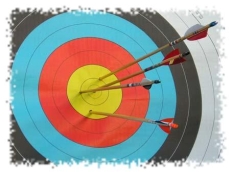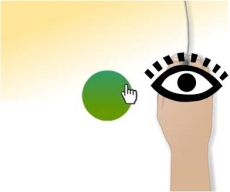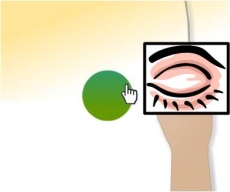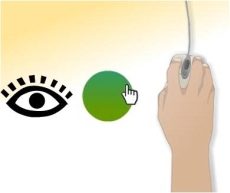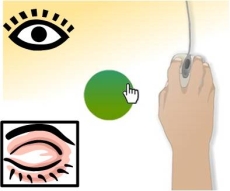Research ->Projects, Publications, Software, People Projects -> Utilities for the Eye Tracking Research
|
|||
| Calibration Accuracy Measurement Tool | |||
|
Goal: Measure the accuracy of calibration of a subject. Implementation: This interface visually displays calibration error for each eye for 17 points displayed on the screen. Average calibration error between all points is presented for the eye-gaze (averaged point of regard between the left and right eye) and left and right eye separately. This tool is extremely useful to determine if the eye-tracker is appropriate for a specific subject, i.e., high error value will provide high noise for measurement experiments. Requirements: Tobii eye-tracker Download: [.zip] Developed By: Dr. Oleg Komogortsev & Sandeep M. Gowda |
||
| Eye-Gaze Interaction by Dwell Time | |||
|
Goal: Eye-gaze guided human computer interaction. Implementation: Eye-gaze data controls mouse cursor. Eye position coordinates are averaged out within a sliding window to provide the coordinates for the mouse cursor. Mouse click is generated by a fixation with specified duration. Both sliding window size and fixation duration can be adjusted in the program’s interface. Requirements: Tobii eye-tracker Download: [.zip] Developed By: Dr. Oleg Komogortsev & Sandeep M. Gowda |
||
| Eye -Gaze Interaction by Blinking | |||
|
Goal: Eye-gaze guided human computer interaction. Implementation: Eye-gaze data controls mouse cursor. Eye position coordinates are averaged out within a sliding window to provide the coordinates for the mouse cursor. Mouse click is generated by an eye blink. Both sliding window size and number of blinks (defines a single click action) can be adjusted in the program’s interface. Requirements: Tobii eye-tracker Download: [.zip] Developed By: Dr. Oleg Komogortsev & Sandeep M. Gowda |
||
| Mouse Aided Intelligent Eye-Gaze Interaction | |||
|
Goal: Eye-gaze guided human computer interaction. Implementation: Eye-gaze data controls mouse cursor when a user is not performing any mouse movement for a short period of time. Any mouse action disables mouse control. The purpose of such approach is to enjoy the accuracy of mouse input and while increasing the speed of interaction by warping mouse cursor to a location of interest. Two important parameters must be considered in this interaction scheme: 1) time interval between the last mouse action and the onset of eye-gaze-based cursor control 2) minimum saccade amplitude that allows eye-gaze-based cursor movement. In other aspects eye-gaze interaction is similar to Eye-Gaze Interaction by Dwell Time. Requirements: Tobii eye-tracker Download: [.zip] Developed By: Dr. Oleg Komogortsev & Sandeep M. Gowda |
||
| Performance Evaluation Tool – Mouse vs. Dwell Time vs. Blink | |||
|
Goal: Evaluate the performance of various eye-gaze interaction modalities and a mouse. Implementation: This tool allows to quickly comparing various interaction methods when the eye tracker is involved. Three HCI approaches are selected: regular mouse interaction, Eye-Gaze Interaction by Dwell Timeand Eye-Gaze Interaction by Blinking. The interface allows selecting the modality of interaction and measure the performance time of each interaction method. The user has to complete a simple task of triggering a sequence of randomly generated numbers by employing selected interaction modality. Performance time of each task is measured in seconds. Requirements: Tobii eye-tracker Download: [.zip] Developed By: Dr. Oleg Komogortsev & Sandeep M. Gowda |
||
Koh, D., Gowda, S., Komogortsev, O. Input Evaluation of an Eye-Gaze-Guided Interface: Kalman Filter vs. Velocity Threshold Eye Movement Identification. Proceedings of the ACM SIGCHI symposium on engineering interactive computing systems (EICS 2009), July 2009. [.pdf] |
|||
